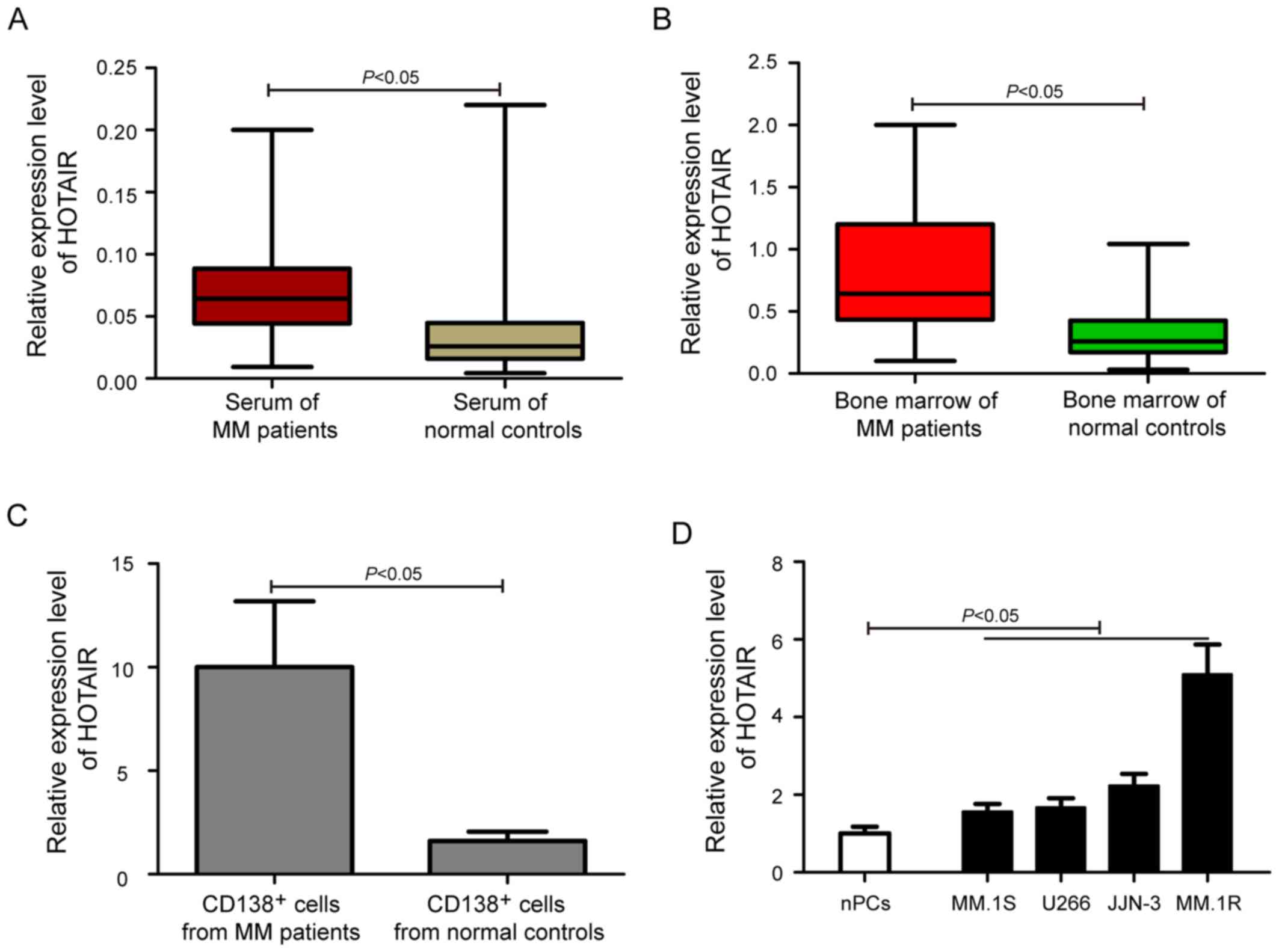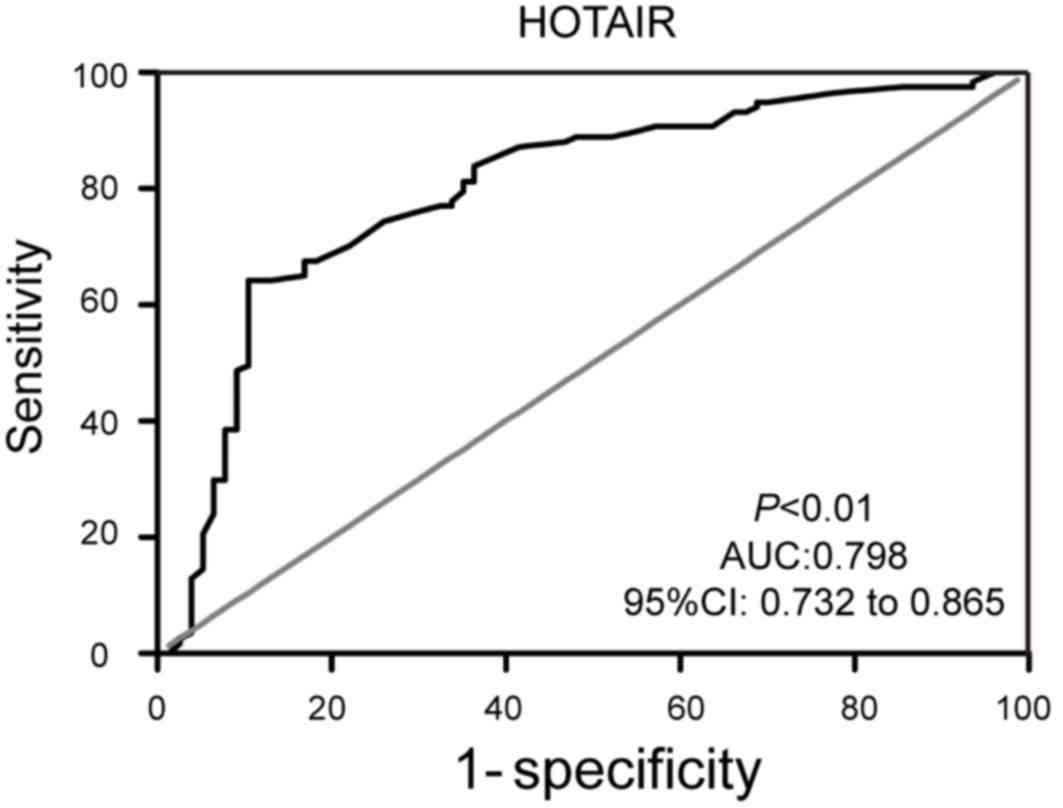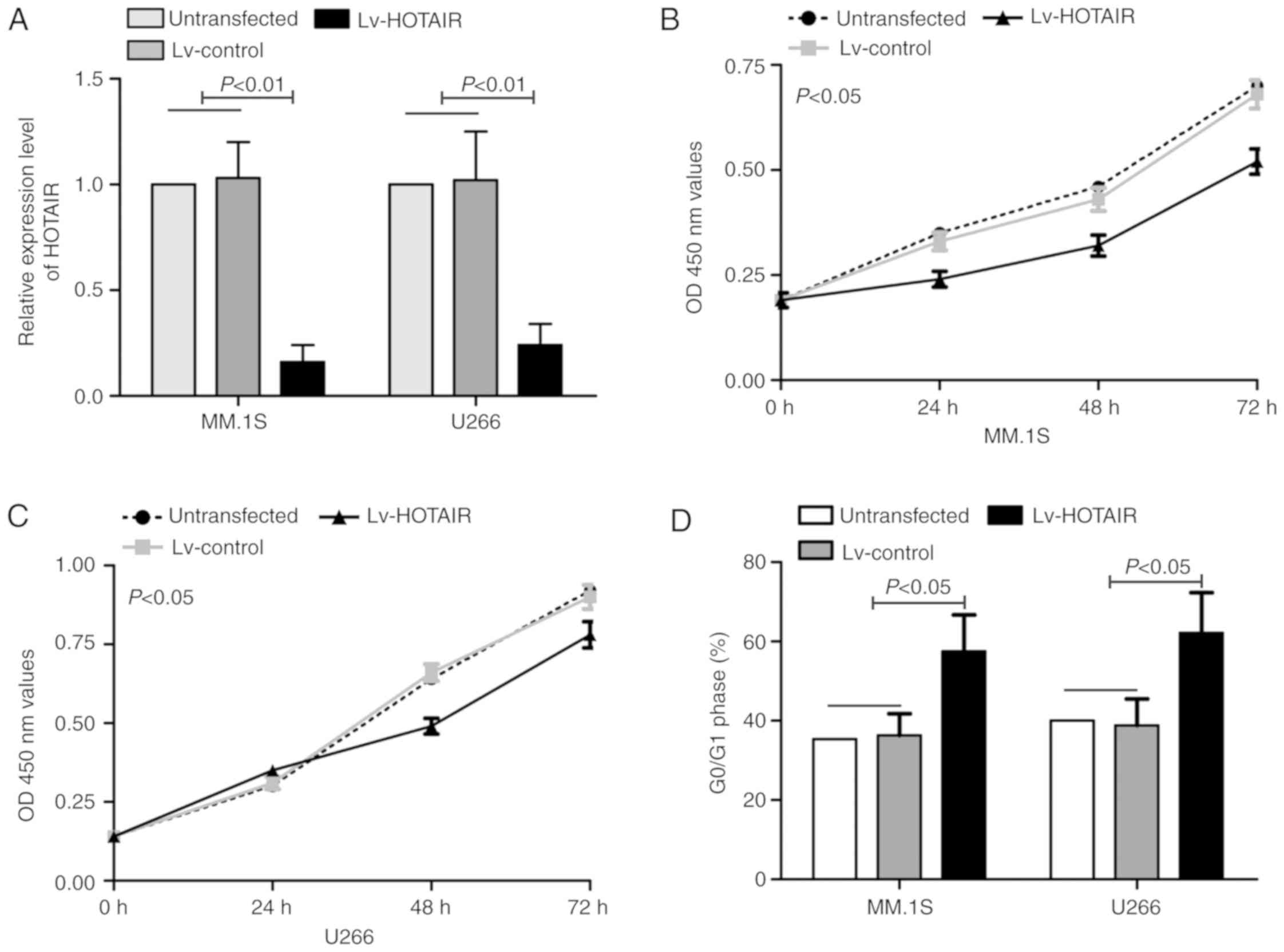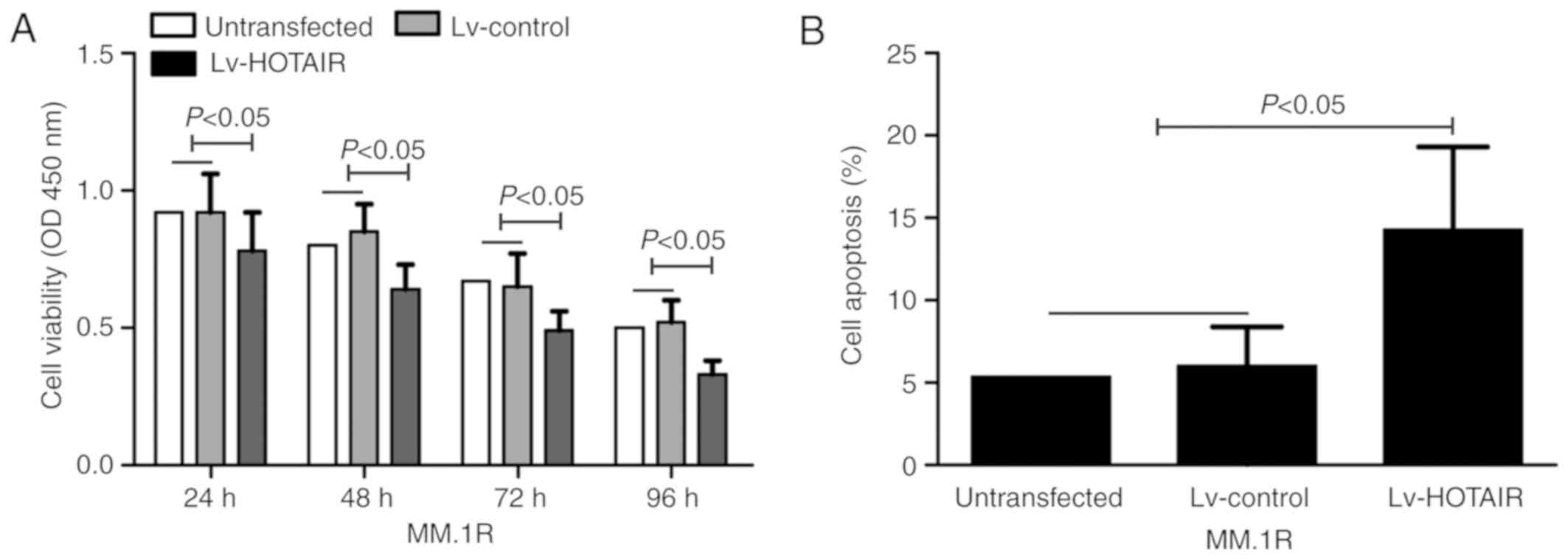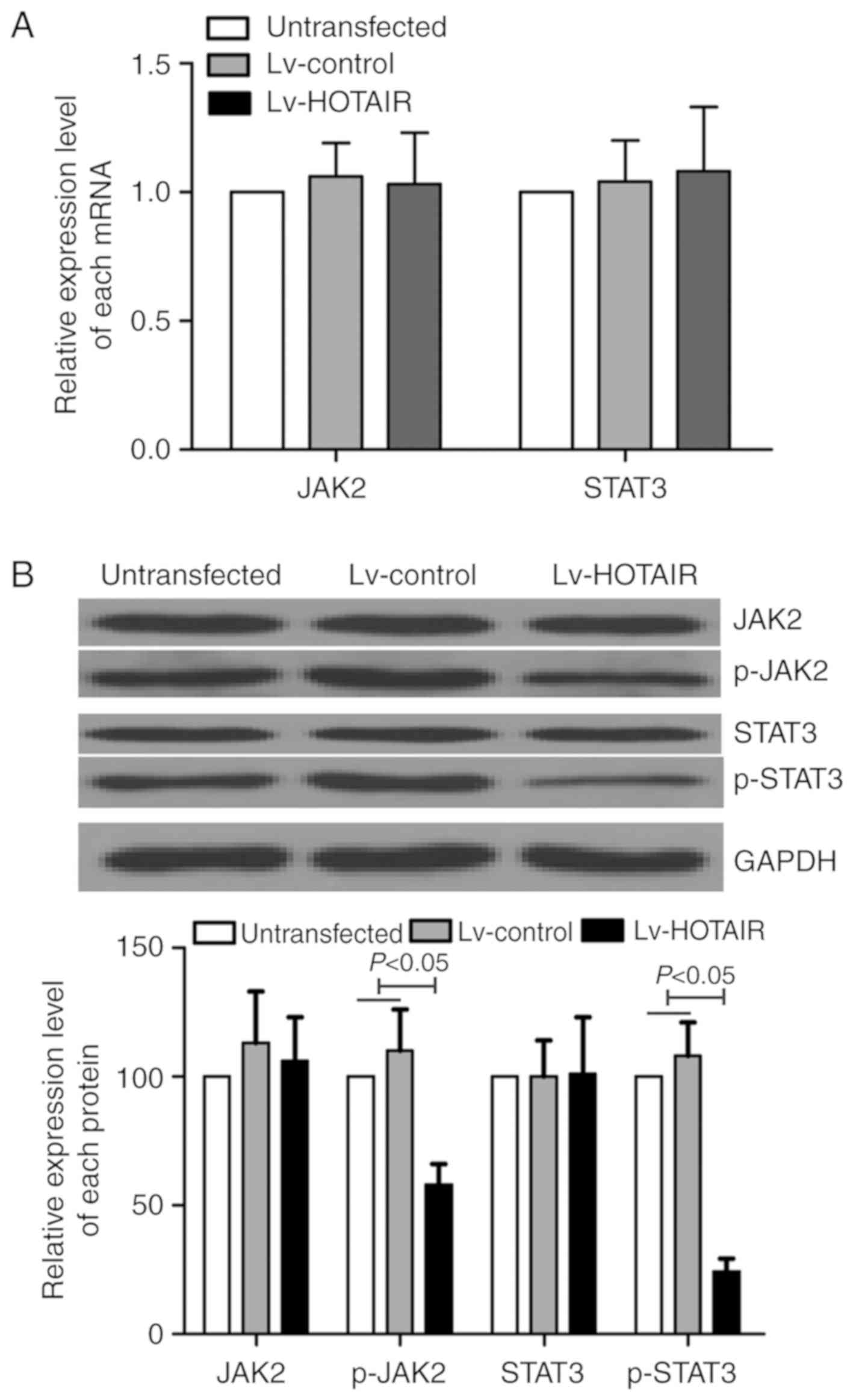Introduction
Long non-coding RNAs (lncRNAs) are a newly reported
type of non-coding RNAs, which are greater than 200 nucleotides in
length and are unable to encode proteins (1). lncRNAs are involved in cellular
development, genomic imprinting and homeostasis, and numerous
studies suggest that dysregulated expression of lncRNAs occurs in
various diseases and contributes to tumor biology, including
multiple myeloma (MM) (2). For
example, Wang et al (3)
showed that lncRNA PRAL plays a critical role in the progression of
MM, and PRAL could become a novel diagnostic, prognostic and
therapeutic candidate for MM patients. Moreover, Zhang et al
(4) reported that lncRNA UCA1
promotes MM cell growth by targeting TGF-β, and overexpression of
TGF-β partially reverses the effects of UCA1 knockdown. Chen et
al (5), identified that lncRNA
CCAT1 exerts an oncogenic role in MM by promoting tumor
progression, and CCAT1 could serve as a novel diagnostic marker and
therapeutic target for MM. However, the associations between others
lncRNAs and MM remain unclear, and related reports are lacking.
MM is a type of malignant plasma-cell disorder,
which originates from plasma cells of the bone marrow leading to
the overproduction of immunoglobulins (6). MM is the second most common
hematological malignant tumor, with approximately 80,000 newly
diagnosed cases annually worldwide (7). Despite the significant progress in
elucidation of the molecular biology of MM and therapeutic options
over the past few decades, MM remains incurable, and its 5-year
survival rate is approximately 40% (8,9).
Currently, the etiologies and pathogenesis of MM remain poorly
understood, and therapies are usually complicated and have poor
efficacy. Dexamethasone (DEX) is a key front-line chemotherapeutic
agent used for B-cell malignant MM, yet MM cells often become
DEX-resistant (10). Therefore, it
is urgent to explore the novel functional mechanism of MM and
identify new biomarkers to provide effective therapeutic targets
for MM.
In 2007, Rinn et al (11) first identified an lncRNA that
regulated gene expression in the trans rather than
cis at the HOXC gene locus on chromosome 12, and named the
lncRNA as HOX antisense intergenic RNA (HOTAIR). Gupta et al
(12), subsequently found that
HOTAIR expression is higher in breast cancer, and is associated
with tumor metastasis and poor prognosis. Further research showed
that HOTAIR is upregulated and plays a significant role in lung
cancer, colorectal cancer, hepatocellular carcinoma, nasopharyngeal
carcinoma and pancreatic cancer (13). More recently, HOTAIR has been shown
to play an oncogenic role in acute myeloid leukemia due to its
ability to mediate the migration and invasion of leukemia cells
(14). Although HOTAIR plays key
roles in different solid cancers and acute myeloid leukemia, little
is known concerning its specific function and molecular mechanism
in MM.
In the present study, the expression and function of
HOTAIR were investigated in MM. Our data showed that the expression
levels of HOTAIR were significantly upregulated in serum, bone
marrow and primary CD138+ cells from MM patients
compared with those from normal controls, and increased serum
HOTAIR may be used as an ideal biomarker for MM detection.
Functional assays showed that knockdown of HOTAIR suppressed MM
cell viability and arrested the cell cycle in the G0/G1 phase.
Furthermore, it was found that HOTAIR increased the chemoresistance
of MM to DEX by regulating the JAK2/STAT3 signaling pathway. These
data may provide novel theoretical bases for the application of
lncRNA HOTAIR in the diagnosis and therapy of MM.
Materials and methods
MM samples
Peripheral blood and bone marrow samples were
collected from 118 MM patients with a mean age of 54.18 years (51
males and 67 females) who were hospitalized at the Department of
Hematology, Daqing Oilfield General Hospital from August 2009 to
April 2015. Seventy-eight healthy volunteers with a mean age of
56.05 years (36 males and 42 females) were collected as normal
controls. All patients were free from other coexisting malignant
diseases. Patients with extramedullary myeloma were not enrolled in
the present study. No local or systemic treatment had been
conducted before operation. For the use of clinical samples for
research, the study was approved by the Ethics Committee of Daqing
Oilfield General Hospital and performed in accordance with the
Declaration of Helsinki (2000). Written informed consent was
obtained from all participants. Samples were freshly frozen in
liquid nitrogen, and then were stored at −80°C until RNA
extraction.
Cell lines and cell culture
MM cell lines (MM.1S, MM.1R, JJN-3 and U266) and
normal plasma cells (nPCs) were purchased from the American Type
Culture Collection (ATCC, Manassas, VA, USA). All the cells were
routinely cultured in RPMI-1640 medium (Thermo Fisher Scientific,
Inc.) supplemented with 10% (vol/vol) FBS (Thermo Fisher
Scientific, Inc.) and 1% penicillin/streptomycin in a 5%
CO2 atmosphere at 37°C. Primary CD138+ cells
were isolated and purified from bone marrow of MM patients and
healthy volunteers by using CD138-coated magnetic beads (Miltenyi
Biotec, Paris, France). Primary CD138+ cells were
freshly frozen in liquid nitrogen, and then were stored at −80°C
for further use.
Quantitative PCR (qPCR)
Total RNA was extracted from cells or samples using
TRIzol reagent (Thermo Fisher Scientific, Inc.), according to the
manufacturer's instructions. A TaqMan™ MicroRNA Reverse
Transcription kit (cat. no. 4366597; Thermo Fisher Scientific,
Inc.) was used to reversely transcribe RNA into cDNA. qPCR was
performed with a Mir-X™ miRNA qRT-PCR TB Green™ kit (cat. no.
638314; Takara, Beijing, China) on the Applied Biosystems 7500
Sequence Detection system (Thermo Fisher Scientific, Inc.) in
triplicate with the following cycling conditions: 95°C for 10 min
(initial denaturation), and then 40 cycles of 95°C for 10 sec, 60°C
for 30 sec. The specific primers for HOTAIR, GAPDH, JAK2 and STAT3
were designed and synthesized by GenePharma Co., Ltd. (Shanghai,
China). GAPDH was used as an internal control. The primer sequences
were as follows: HOTAIR forward, 5′-CCCTCAGGTCCCTAATA-3′ and
reverse, 5′-CCGCCGTCTGTAACTCT-3′; GAPDH forward,
5′-CCACTCCTCCACCTTTG-3′ and reverse, 5′-ACCACCCTGTTGCTGT-3′; JAK2
forward, 5′-ACCTGGTGAAAGTCCC-3′ and reverse,
5′-CCAATCATACGCATAAA-3′; STAT3 forward, 5′-AGACCCACTCCTTGCC-3′ and
reverse, 5′-GCTCAGTCCTCGCTTG-3′. Results were normalized to the
expression of GAPDH, and the 2−ΔΔCq method (15) was used for analysis of the
quantitative changes in expression of each gene.
Plasmid construction and cell
transfection
Lentivirus for short hairpin RNA (shRNA) directed
against HOTAIR (Lv-HOTAIR) and control lentiviral vector
(Lv-control) were chemically synthesized from GenePharma Co., Ltd.
(Shanghai, China). The sequences of the shRNAs were as follows:
5′-GAACGGGAGTACAGAGAGA-3′ (Lv-HOTAIR) and
5′-GACTGATTCGATACGCTATGT-3′ (Lv-control). Cells were plated in
6-well plates and transfected with Lv-HOTAIR or Lv-control using
Lipofectamine 2000 (Thermo Fisher Scientific, Inc.), according to
the manufacturer's instructions. Twenty-four h post-transfection,
the transfected cells were selected with 800 mg/ml G418 for at
least one month. After selection and isolation of stably
transfected clones, the clones were analyzed for HOTAIR expression
using qPCR assay.
Flow cytometric assay
For analysis of cell apoptosis, the stably
transfected cells were co-cultured with 50 µM DEX (cat. no. D4902;
Sigma-Aldrich; Merck KGaA) for 48 h. Then, the cells were harvested
and resuspended in fixation fluid. Propidium iodide (PI) (2 µl) and
Annexin V-FITC (5 µl) were added to the cell suspension for 30 min
at 37°C. The cell suspension was analyzed using FACSCalibur flow
cytometry (BD Biosciences, USA). The percentage of early apoptotic
cells was counted and compared for the cells receiving different
treatments. For analysis of cell cycle distribution, at 48 h
post-transfection, the cells were harvested via trypsinization,
washed with cold PBS and fixed in 70% ice cold ethanol overnight,
followed by staining with 50 mg/ml PI for 30 min. Finally, the
samples were detected with FACSCalibur flow cytometry.
Cell viability assay
Cell viability was measured using a Cell Counting
Kit-8 (CCK-8 kit) (Dojindo, USA), according to the manufacturer's
instructions. Cells were seeded in a 96-well plate at
3×103 cells/well and incubated in a 5% CO2
and 37°C humidified incubator with 100 µl final volume. After
incubation with 50 µM DEX for 24, 48, 72 and 96 h, 10 µl CCK-8 (5
mg/ml) was added to each well, and the cells were incubated at 37°C
for 4 h. The absorbance at 450 nm in each well was detected using a
micro-plate analyzer (Bio-Tek Instruments, USA).
Western blot analysis
Cells were lysed with RIPA buffer (Thermo Fisher
Scientific, Inc.) according to the manufacturer's instructions, and
the concentration of proteins was quantified using a BCA Protein
Assay Kit (Beyotime, China). Equal amounts (30 µg) of proteins were
separated by 10% SDS-PAGE and electrophoretically transferred onto
PVDF membranes (EMD Millipore). After being blocked with 5% non-fat
milk at 37°C for 2 h, the membranes were incubated with specific
primary antibodies against JAK2 (cat. no. ab108596; 1:1,000),
phospho-JAK2 (p-JAK2; cat. no. ab32101; 1:500), STAT3 (cat. no.
ab68153; 1:500) and phospho-STAT3 (p-STAT3; cat. no. ab32143;
1:1,000) overnight at 4°C. GAPDH was used as an internal loading
control. All primary antibodies were purchased from Abcam. Finally,
the membranes were washed three times with TBST buffer and
incubated with HRP-conjugated goat anti-rabbit immunoglobulin G
(cat. no. AS014; ABclonal Technology) for 2 h at 37°C. The bands
were detected using an ECL detection system (Pierce Biotechnology)
and analyzed using the Image-Pro plus software (version 6.0; Media
Cybernetics Inc.).
Statistical analysis
All results from three independent experiments are
expressed as mean ± SD and were analyzed using Statistical Product
and Service Solutions (SPSS) 17.0 (SPSS, Inc., Chicago, IL, USA).
Differences among the groups were estimated by Student's t-test or
one-way ANOVA followed by Student-Newman-Keuls test. Receiver
operating characteristic (ROC) curves were plotted, and the area
under the ROC curve (AUC) was calculated to assess the specificity
and sensitivity of predicting MM patients and normal controls.
P<0.05 was considered to indicate a statistically significant
difference.
Results
HOTAIR is upregulated in MM samples
and cell lines
To explore whether HOTAIR is detectable and altered
in MM, the expression of HOTAIR was examined by qPCR in our
collection of peripheral blood from 118 MM patients and 78 healthy
volunteers. As presented in Fig.
1A, elevated expression of HOTAIR was observed in the serum of
MM patients compared with that noted in the normal controls
(P<0.05). We then determined HOTAIR expression in bone marrow
samples, and the results revealed that HOTAIR expression in MM
patients was significantly higher than that in normal controls
(P<0.05; Fig. 1B). To further
test the hypothesis that serum HOTAIR was primarily released from
tumor cells, the expression level of HOTAIR in primary
CD138+ cells was also detected. The results showed that
HOTAIR expression was significantly upregulated in the primary
CD138+ cells from MM patients compared to those from the
normal controls (P<0.05; Fig.
1C). Finally, HOTAIR expression was investigated in MM cell
lines including MM.1S, MM.1R, JJN-3 and U266, and normal plasma
cells (nPCs). The results revealed that the HOTAIR level was
considerably increased in the four MM cell lines compared to this
level in the nPCs cells (P<0.05; Fig. 1D). According to the relatively high
levels of HOTAIR in MM.1S, U266 and MM.1R cells, and the fact that
these cell lines are suitable models for MM as described previously
(16,17), three cell lines were selected for
further study in vitro.
HOTAIR exhibits a higher diagnostic
value for MM
To investigate the characteristic of HOTAIR as a
potential diagnostic biomarker for MM patients, ROC curve was
performed on data from clinical samples. As presented in Fig. 2, representation of the data showed
the AUC of HOTAIR was 0.798 (95% CI, 0.732–0.865), and the
sensitivity and specificity were 70.12 and 79.94%,
respectively.
Knockdown of HOTAIR suppresses MM cell
viability by altering the cell cycle
To further investigate the biological roles of
HOTAIR in MM cells in vitro, stable inhibition of HOTAIR
expression was established in MM.1S and U266 cell lines using
Lv-HOTAIR. As confirmed by qPCR analysis, HOTAIR expression in
MM.1S and U266 cells was significantly downregulated by Lv-HOTAIR
compared with the expression in the Lv-control-treated and
untransfected cells (P<0.01; Fig.
3A). These data indicated that cell transfection was
successful, and Lv-HOTAIR is a suitable target to knock down HOTAIR
in MM.1S and U266 cells. Then, a CCK-8 assay was performed to
detect the role of HOTAIR in the cell viability of MM cells. The
results showed that knockdown of HOTAIR inhibited cell viability of
the MM.1S and U266 cell lines compared to the cell viability of the
Lv-control groups (P<0.05; Fig. 3B
and C). To determine whether the function of HOTAIR in regards
to cell viability was caused by alteration of the cell cycle, flow
cytometry was performed. Cell cycle analysis showed that knockdown
of HOTAIR induced MM cell cycle arrest at the G0/G1 phase
(P<0.05; Fig. 3D).
Knockdown of HOTAIR decreases MM
chemoresistance to DEX by regulating the JAK2/STAT3 signaling
pathway
To investigate whether HOTAIR plays a role in the
DEX resistance of MM cells, CCK-8 assay and flow cytometric
analysis were carried out to investigate the influence of HOTAIR on
the viability and apoptosis of MM cell lines to 50 µM DEX. As shown
in Fig. 4A and B, knockdown of
HOTAIR significantly decreased the chemoresistance of MM.1R cells
to 50 µM DEX by reducing cell viability at 24, 48, 72 and 96 h, and
inducing cell apoptosis at 48 h (P<0.05). To confirm whether the
effect of HOTAIR on DEX chemoresistance was mediated by the
JAK2/STAT3 pathway, qPCR and western blot analysis were performed.
The results showed that the mRNA levels of JAK2 and STAT3 in the
MM.1R cells demonstrated no significant difference between the
Lv-HOTAIR and Lv-control groups (Fig.
5A). Compared with the Lv-control groups, as determined by
western blot analysis, expression levels of p-JAK2 and p-STAT3
levels were significantly downregulated in MM.1R cells by HOTAIR
inhibition; in contrast, no obvious total protein expression
changes in JAK2 and STAT3 were observed between cells receiving
different treatments (P<0.05; Fig.
5B). Taken together, these data suggest that JAK2/STAT3
signaling mediated the effect of HOTAIR on MM chemoresistance to
DEX.
Discussion
Multiple myeloma (MM) is a hematological malignancy
characterized by abnormal growth of monoclonal plasma cells in the
bone marrow leading to various end-organ damage including
hypercalcemia, anemia, osteolytic bone disease and renal
insufficiency (18). During the
past few years, great progress has been achieved in understanding
the initiation and tumorigenesis of MM; however, the clinical
prognosis of patients with MM still remains highly heterogeneous
(8,9). Traditional laboratory biomarkers
including β2M, IgG and serum albumin have been used as an objective
staging system for MM (19,20).
However, these biomarkers have demonstrated limited ability for
diagnostic risk stratification. Due to the rapid development of
basic medical research, an increasing number of studies have shown
that abnormal expression of lncRNAs is detectable in the plasma of
cancer patients and therefore may be utilized as a tool for cancer
diagnosis (21,22). For example, Shen et al
(23) reported that serum lncRNA
PCAT-1 is expressed at a higher level in MM patients than that in
healthy controls, and may serve as a valuable biomarker in the
auxiliary diagnosis of MM. However, the clinical significance and
molecular mechanisms of specific lncRNAs warrant further
investigation.
HOTAIR (HOX antisense intergenic RNA), as a spliced
and polyadenylated RNA, has six exons with 2.2-kb nucleotides in
length. Accumulating evidence suggests that HOTAIR plays a critical
role in various areas of human cancer, such as growth, survival,
invasion, migration, drug resistance and genomic stability
(13). Nevertheless, few studies
have evaluated the role of serum HOTAIR in the diagnostic value for
cancer. A recent study showed that serum HOTAIR could serve as a
promising biomarker for diagnosing and monitoring non-small cell
lung cancer (24). Elsayed et
al (25) concluded that plasma
HOTAIR may serve as a potential non-invasive biomarker for the
diagnosis of gastric cancer. Tan et al (26) demonstrated that serum HOTAIR could
be used as a novel prognostic and diagnostic biomarker for
glioblastoma multiforme. In addition, Wang et al (27) reported that serum HOTAIR may serve
as a potential biomarker for the diagnosis of esophageal squamous
cell carcinoma. However, the diagnostic value and functional role
of HOTAIR in MM are still largely unknown. To the best of our
knowledge, this is the first study to demonstrate the clinical
significance of serum HOTAIR as a diagnostic biomarker for MM. Our
results showed a significant upregulation of serum HOTAIR in MM
patients compared with that noted in normal controls, and its
capability of discriminating between MM patients and healthy
volunteers had 70.12% sensitivity and 79.94% specificity. Moreover,
it was also determined that HOTAIR expression was increased in bone
marrow and primary CD138+ cells from MM patients as well
as in MM cell lines. Therefore, these data indicated that
upregulation of serum HOTAIR may prove to be a novel biomarker for
MM diagnosis.
To further investigate the biological role of HOTAIR
in MM cells, CCK-8 assay and flow cytometric analysis were carried
out to investigate the influences of HOTAIR on the viability and
apoptosis of MM cell lines. Function assays showed that silencing
of HOTAIR significantly suppressed MM cell viability by arresting
the cell cycle in the G0/G1 phase. Dexamethasone (DEX) is one of
the most widely used glucocorticoids, which was introduced as a
treatment regimen for MM in the 1970s, and its efficacy was
observed in up to 70% of MM patients in clinical trials (28). Recent studies have found that MM
cells are resistant to DEX, and some therapeutic strategies for
overcoming DEX resistance have been reported (10). For example, miR-221-222 plays a
role in DEX-induced drug resistance in MM, and treatment with
anti-miR-221-222 was found to partially restore the DEX sensitivity
of MM.1R cells (29). NEAT1
inhibition was found to decrease DEX resistance in MM by targeting
the miR-193a/MCL1 pathway (16).
Importantly, our results showed that knockdown of HOTAIR
significantly decreased the chemoresistance of MM.1R cells to DEX
by reducing cell viability and inducing cell apoptosis. These data
indicate that inhibition of HOTAIR suppresses MM cell viability and
decreases DEX resistance.
Signal transducer and activator of transcription 3
(STAT3) is an oncogenic transcription factor and is widely
expressed in a broad range of cancers including MM, and plays an
important role in regulating cellular activities (30). STAT3 was found to be highly
expressed in more than 63% of CD138+ bone marrow cells
of MM patients and is associated with chemoresistance to DEX
therapy (31). Currently, the
JAK2/STAT3 signaling pathway has been proposed as a promising
target for MM therapy (32). To
confirm whether the effect of HOTAIR on DEX chemoresistance was
mediated by the JAK2/STAT3 pathway, qPCR and western blot analysis
were conducted. The data showed that inhibition of HOTAIR
significantly downregulated the expression levels of p-JAK2 and
p-STAT3 in MM.1R cells, whereas no obvious changes in the mRNA and
total protein expression of JAK2 and STAT3 were observed after
cells were transfected with Lv-HOTAIR. These important findings
suggest that JAK2/STAT3 signaling mediates the effects of HOTAIR in
regards to the chemoresistance of MM to DEX.
In summary, our results suggest that serum HOTAIR is
a novel biomarker for the diagnosis of MM, and knockdown of HOTAIR
was found to inhibit MM cell viability by arresting the cell cycle
in the G0/G1 phase. In addition, we conclude that HOTAIR promotes
MM chemoresistance to DEX via the JAK2/STAT3 signaling pathway,
indicating that HOTAIR may also serve as a potential therapeutic
target for MM.
Acknowledgements
Not applicable.
Funding
No funding was received.
Availability of data and materials
All data generated or analyzed during the present
study are included in this published article.
Authors' contributions
WW designed the study. RG, BF and YP performed the
experiments. YL and HL performed the statistical analyses. WW and
RG prepared the manuscript. All authors reviewed and edited the
final manuscript. All authors read and approved the manuscript and
agree to be accountable for all aspects of the research in ensuring
that the accuracy or integrity of any part of the work are
appropriately investigated and resolved.
Ethics approval and consent to
participate
This study was approved by the Ethics Board of
Daqing Oilfield General Hospital and was performed in accordance
with the Declaration of Helsinki (2000). Written informed consent
was obtained from all participants.
Patient consent for publication
Not applicable.
Competing interests
The authors declare that they have no competing
interests.
References
|
1
|
Spizzo R, Almeida MI, Colombatti A and
Calin GA: Long non-coding RNAs and cancer: A new frontier of
translational research? Oncogene. 31:4577–4587. 2012. View Article : Google Scholar : PubMed/NCBI
|
|
2
|
Nobili L, Ronchetti D, Agnelli L, Taiana
E, Vinci C and Neri A: Long non-coding RNAs in multiple myeloma.
Genes (Basel). 9(pii): E692018. View Article : Google Scholar : PubMed/NCBI
|
|
3
|
Wang H, Wang J, Liang CF and Zhou T:
Expression of long non-coding RNA PRAL as a potential biomarker for
diagnosis in non-small-cell lung cancer patients is associated with
the inhibition of cell proliferation and metastasis. Clin Lab.
64:1341–1348. 2018. View Article : Google Scholar : PubMed/NCBI
|
|
4
|
Zhang ZS, Wang J, Zhu BQ and Ge L: Long
noncoding RNA UCA1 promotes multiple myeloma cell growth by
targeting TGF-β. Eur Rev Med Pharmacol Sci. 22:1374–1379.
2018.PubMed/NCBI
|
|
5
|
Chen L, Hu N, Wang C, Zhao H and Gu Y:
Long non-coding RNA CCAT1 promotes multiple myeloma progression by
acting as a molecular sponge of miR-181a-5p to modulate HOXA1
expression. Cell Cycle. 17:319–329. 2018. View Article : Google Scholar : PubMed/NCBI
|
|
6
|
Spitzer TR, Sachs DH and Cosimi B:
Multiple myeloma. N Engl J Med. 364:23642011. View Article : Google Scholar : PubMed/NCBI
|
|
7
|
Jemal A, Bray F, Center MM, Ferlay J, Ward
E and Forman D: Global cancer statistics. CA Cancer J Clin.
61:69–90. 2011. View Article : Google Scholar : PubMed/NCBI
|
|
8
|
Kuehl WM and Bergsagel PL: Molecular
pathogenesis of multiple myeloma and its premalignant precursor. J
Clin Invest. 122:3456–3463. 2012. View
Article : Google Scholar : PubMed/NCBI
|
|
9
|
Anderson KC: Progress and paradigms in
multiple myeloma. Clin Cancer Res. 22:5419–5427. 2016. View Article : Google Scholar : PubMed/NCBI
|
|
10
|
Robak P, Drozdz I, Szemraj J and Robak T:
Drug resistance in multiple myeloma. Cancer Treat Rev. 70:199–208.
2018. View Article : Google Scholar : PubMed/NCBI
|
|
11
|
Rinn JL, Kertesz M, Wang JK, Squazzo SL,
Xu X, Brugmann SA, Goodnough LH, Helms JA, Farnham PJ, Segal E and
Chang HY: Functional demarcation of active and silent chromatin
domains in human HOX loci by noncoding RNAs. Cell. 129:1311–1323.
2007. View Article : Google Scholar : PubMed/NCBI
|
|
12
|
Gupta RA, Shah N, Wang KC, Kim J, Horlings
HM, Wong DJ, Tsai MC, Hung T, Argani P, Rinn JL, et al: Long
non-coding RNA HOTAIR reprograms chromatin state to promote cancer
metastasis. Nature. 464:1071–1076. 2010. View Article : Google Scholar : PubMed/NCBI
|
|
13
|
Tang Q and Hann SS: HOTAIR: An oncogenic
long non-coding RNA in human cancer. Cell Physiol Biochem.
47:893–913. 2018. View Article : Google Scholar : PubMed/NCBI
|
|
14
|
Xing CY, Hu XQ, Xie FY, Yu ZJ, Li HY,
Bin-Zhou, Wu JB, Tang LY and Gao SM: Long non-coding RNA HOTAIR
modulates c-KIT expression through sponging miR-193a in acute
myeloid leukemia. FEBS Lett. 589:1981–1987. 2015. View Article : Google Scholar : PubMed/NCBI
|
|
15
|
Livak KJ and Schmittgen TD: Analysis of
relative gene expression data using real-time quantitative PCR and
the 2(-Delta Delta C(T)) method. Methods. 25:402–408. 2001.
View Article : Google Scholar : PubMed/NCBI
|
|
16
|
Wu Y and Wang H: LncRNA NEAT1 promotes
dexamethasone resistance in multiple myeloma by targeting
miR-193a/MCL1 pathway. J Biochem Mol Toxicol. 32:Jan;2018.doi:
10.1002/jbt.22008. View Article : Google Scholar :
|
|
17
|
Li QY, Chen L, Hu N and Zhao H: Long
non-coding RNA FEZF1-AS1 promotes cell growth in multiple myeloma
via miR-610/Akt3 axis. Biomed Pharmacother. 103:1727–1732. 2018.
View Article : Google Scholar : PubMed/NCBI
|
|
18
|
Kumar SK, Rajkumar V, Kyle RA, van Duin M,
Sonneveld P, Mateos MV, Gay F and Anderson KC: Multiple myeloma.
Nat Rev Dis Primers. 3:170462017. View Article : Google Scholar : PubMed/NCBI
|
|
19
|
Moreaux J, Hose D, Reme T, Jourdan E,
Hundemer M, Legouffe E, Moine P, Bourin P, Moos M, Corre J, et al:
CD200 is a new prognostic factor in multiple myeloma. Blood.
108:4194–4197. 2006. View Article : Google Scholar : PubMed/NCBI
|
|
20
|
Perosa F, Minoia C, Favoino E, Prete M and
Dammacco F: Staging multiple myeloma patients with active disease
using serum levels of beta2m-free HLA class I heavy chain together
with IgM or platelet count. Blood Cells Mol Dis. 42:71–76. 2009.
View Article : Google Scholar : PubMed/NCBI
|
|
21
|
Bhan A, Soleimani M and Mandal SS: Long
noncoding RNA and cancer: A new paradigm. Cancer Res. 77:3965–3981.
2017. View Article : Google Scholar : PubMed/NCBI
|
|
22
|
Bolha L, Ravnik-Glavač M and Glavač D:
Long noncoding RNAs as biomarkers in cancer. Dis Markers.
2017:72439682017. View Article : Google Scholar : PubMed/NCBI
|
|
23
|
Shen X, Zhang Y, Wu X, Guo Y, Shi W, Qi J,
Cong H, Wang X, Wu X and Ju S: Upregulated lncRNA-PCAT1 is closely
related to clinical diagnosis of multiple myeloma as a predictive
biomarker in serum. Cancer Biomark. 18:257–263. 2017. View Article : Google Scholar : PubMed/NCBI
|
|
24
|
Li N, Wang Y, Liu X, Luo P, Jing W, Zhu M
and Tu J: Identification of circulating long noncoding RNA HOTAIR
as a novel biomarker for diagnosis and monitoring of non-small cell
lung cancer. Technol Cancer Res Treat. Jan 1–2017.doi:
10.1177/1533034617723754 (Epub ahead of print). View Article : Google Scholar
|
|
25
|
Elsayed ET, Salem PE, Darwish AM and Fayed
HM: Plasma long non-coding RNA HOTAIR as a potential biomarker for
gastric cancer. Int J Biol Markers. Apr 1–2018.doi:
10.1177/1724600818760244 (Epub ahead of print). View Article : Google Scholar : PubMed/NCBI
|
|
26
|
Tan SK, Pastori C, Penas C, Komotar RJ,
Ivan ME, Wahlestedt C and Ayad NG: Serum long noncoding RNA HOTAIR
as a novel diagnostic and prognostic biomarker in glioblastoma
multiforme. Mol Cancer. 17:742018. View Article : Google Scholar : PubMed/NCBI
|
|
27
|
Wang W, He X, Zheng Z, Ma X, Hu X, Wu D
and Wang M: Serum HOTAIR as a novel diagnostic biomarker for
esophageal squamous cell carcinoma. Mol Cancer. 16:752017.
View Article : Google Scholar : PubMed/NCBI
|
|
28
|
Das M: Lenalidomide plus dexamethasone in
multiple myeloma. Lancet Oncol. 19:e122018. View Article : Google Scholar : PubMed/NCBI
|
|
29
|
Zhao JJ, Chu ZB, Hu Y, Lin J, Wang Z,
Jiang M, Chen M, Wang X, Kang Y, Zhou Y, et al: Targeting the
miR-221-222/PUMA/BAK/BAX pathway abrogates dexamethasone resistance
in multiple myeloma. Cancer Res. 75:4384–4397. 2015. View Article : Google Scholar : PubMed/NCBI
|
|
30
|
Arora L, Kumar AP, Arfuso F, Chng WJ and
Sethi G: The role of signal transducer and activator of
transcription 3 (STAT3) and its targeted inhibition in
hematological malignancies. Cancers (Basel). 10(pii): E3272018.
View Article : Google Scholar : PubMed/NCBI
|
|
31
|
Liu T, Fei Z, Gangavarapu KJ, Agbenowu S,
Bhushan A, Lai JC, Daniels CK and Cao S: Interleukin-6 and
JAK2/STAT3 signaling mediate the reversion of dexamethasone
resistance after dexamethasone withdrawal in 7TD1 multiple myeloma
cells. Leuk Res. 37:1322–1328. 2013. View Article : Google Scholar : PubMed/NCBI
|
|
32
|
Zhu S, Wang Z, Li Z, Peng H, Luo Y, Deng
M, Li R, Dai C, Xu Y, Liu S and Zhang G: Icaritin suppresses
multiple myeloma, by inhibiting IL-6/JAK2/STAT3. Oncotarget.
6:10460–10472. 2015. View Article : Google Scholar : PubMed/NCBI
|















